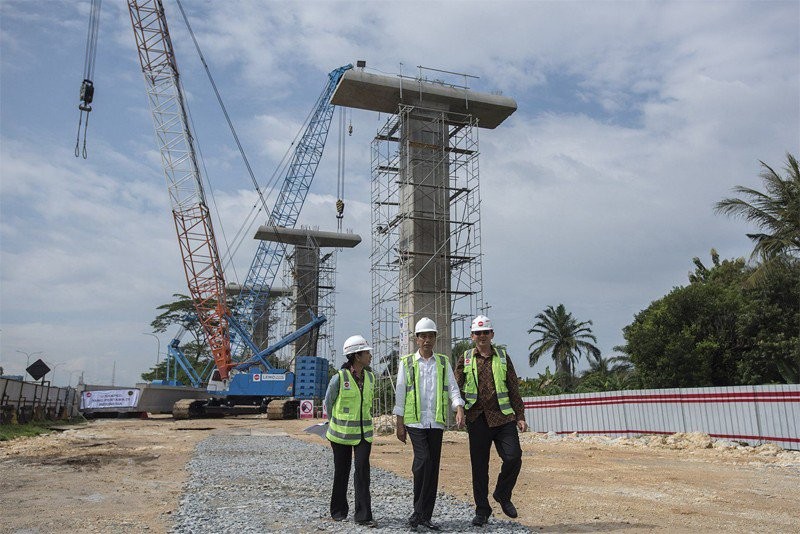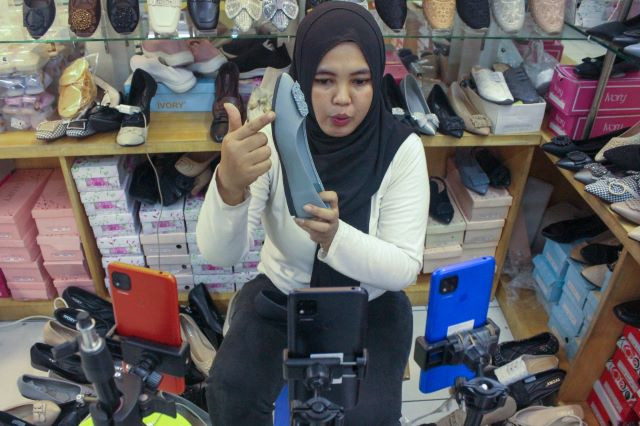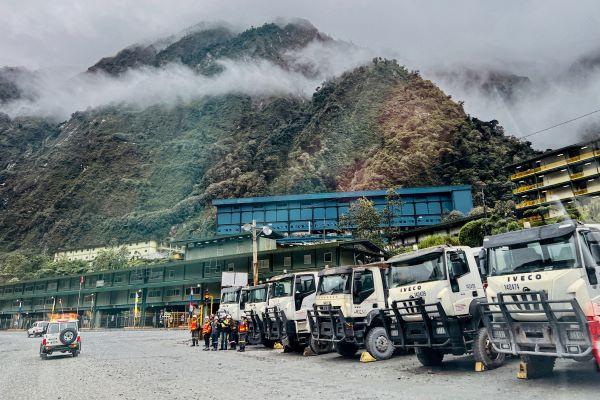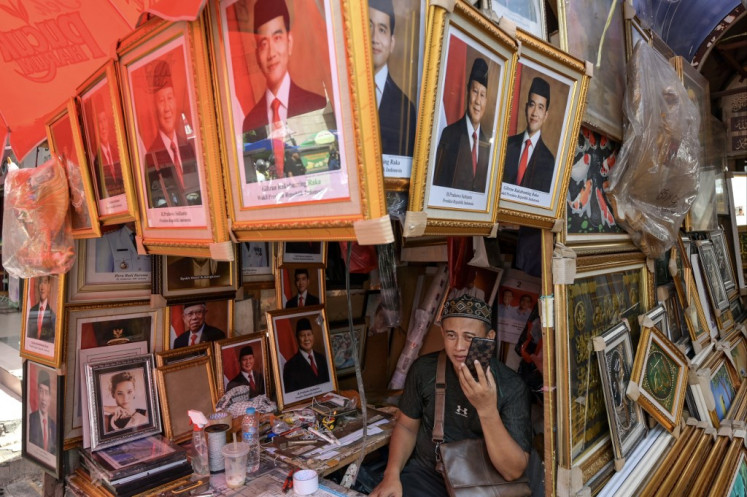Who is responsible for state-owned enterprises' debts?
The government is keeping its state-driven development plan, a decision taken only after the limited success of previous administrations in attracting private investment. Just recently, Jokowi ordered SOEs to triple their investment by 2018.
Change Size
 President Joko "Jokowi" Widodo (center), along with State-Owned Enterprises Minister Rini Soemarno (left) and Jakarta Governor Basuki "Ahok" Tjahaja Purnama, inspects the progress of the light rail transit (LRT) project on Sep. 30 in Jakarta. (Antara/Widodo S. Jusuf)
President Joko "Jokowi" Widodo (center), along with State-Owned Enterprises Minister Rini Soemarno (left) and Jakarta Governor Basuki "Ahok" Tjahaja Purnama, inspects the progress of the light rail transit (LRT) project on Sep. 30 in Jakarta. (Antara/Widodo S. Jusuf)
I
n its first two years, the administration of Joko “Jokowi” Widodo pursued a state-centered development strategy and supported the expansion of state-owned enterprises (SOE) with capital injections. State capital injections into SOEs increased from Rp 3 trillion (US$222 million) in 2014 to Rp 64.5 trillion in 2015. The government is keeping its state-driven development plan, a decision taken only after the limited success of previous administrations in attracting private investment. Just recently, Jokowi ordered SOEs to triple their investment by 2018.
However, the government plans to shift the focus to fiscal sustainability during the second half of the administration, and the capital injection into SOEs is expected to shrink from Rp 50.5 trillion in 2016 (revised budget) to Rp 4 trillion in 2017 (draft budget). That leaves the SOEs with only one option to fund their expansion: debt.
The SOE segment’s share in Indonesia’s debt increased gradually in the first half of the 2010s. At the end of 2015, SOEs accounted for 6.1 percent of bank loans and 19.8 percent of external debt. The shares are expected to rise at an accelerated pace as SOEs’ major infrastructure and factory construction projects begin in the coming years.
On top of injecting capital, the Jokowi government has taken steps to boost the borrowing capacity of SOEs. It is pursuing a plan to establish state-owned holding companies in various economic sectors. The holding companies are expected to have larger assets than the sum of individual SOEs. For example, when a holding company is established in the mining sector, the aggregate assets of mining SOEs are expected to expand from Rp 65.6 trillion to Rp 182.0 trillion.
The government has also offered SOEs tax incentives to reevaluate their assets. The regulation brought down the tax rate on the increase in fixed assets resulting from the revaluation from the original 10 percent to 3 percent for applications filed before 2016. Forty-three SOEs participated in this program in 2015; cumulatively, they saw their assets increase from Rp 1,047 trillion to Rp 1,355 trillion.
Improved domestic credit conditions thanks to aggressive lowering of the key interest rate in 2016 and repatriated funds through the tax amnesty are also a boon for SOEs looking to tap into the debt market.
The government argues that these measures will limit the reliance of SOEs on the state budget in the future and that the government’s direct exposure to SOEs will be limited to the guarantees it provides to certain projects. The government estimates that the guaranteed debt for SOE-led infrastructure projects will be around 0.8 percent of GDP on average between 2015 and 2019.
But is the government really shielded from SOE expansion? There are factors that suggest otherwise.
First, government-owned banks are major lenders in Indonesia. As of September, 46.3 percent of the nation’s total loans were from national and regional state-owned banks. State banks are leading financiers of infrastructure development and have provided large syndicated loans to SOEs involved in key projects, such as PLN and Angkasa Pura II. Moreover, they channel foreign loans to SOEs.
As non-financial SOEs and state banks are intertwined, the deterioration of the former’s financial health will affect the latter. Through this mechanism, the government’s fiscal position would be affected if debt-funded projects go sour.
Second, when SOEs face financial difficulties, governments often take responsibility by bailing them out or acting as a lender of last resort. In other words, there are soft budget constraints.
The Indonesian government has reiterated that SOEs are responsible for their own business expansion and should not expect the government to step in when losses arise. For example, the administration has announced that it will not provide subsidies for the losses that Pertamina will face as a result of the government’s one-fuel-price policy. The policy requires Pertamina to sell fuel at standard prices across the archipelago. Pertamina has estimated that the new policy necessitates additional annual expenditure of Rp 800 billion, most of which will be spent on transportation to remote areas.
Another example is that of the Jakarta-Bandung high-speed railway project. The government awarded the project to a consortium of Chinese and Indonesian SOEs over Japanese firms in 2015. One of the major reasons was that China did not require funds from the Indonesian government. Most of the funding will come from the China Development Bank.
However, it is difficult to imagine that the government will turn a blind eye if the SOEs carrying out social-oriented activities or the nation’s long-cherished infrastructure projects face financial troubles.
One does not have to go far back in time to predict how the Indonesian government will react when SOEs face funding problems. When the government removed subsidies on Premium-branded gasoline but did not adjust the fuel price to reflect the rise in international oil prices in 2015, Pertamina faced Rp 15 trillion in losses from selling the product. As the skepticism toward the sustainability of this pricing practice intensified, the government caved in and promised to compensate the company for its losses.
Even if the government denies reimbursement or financial support in such situations and SOEs are burdened with the losses, SOEs’ tax and dividend payout would be reduced, and this would ultimately affect the government’s fiscal position.
The Indonesian government direly needs to increase investment in productivity-enhancing projects and will inevitably incur debt in the process. Its achievement since the Asian financial crisis in stabilizing the fiscal situation has been remarkable. The government’s debt-to-GDP ratio declined from 87.4 percent in 2000 to 27.3 percent in 2015. Hence, fears that the expansion of SOE debt will lead to fiscal instability may be groundless in the short term.
However, when the party is over, it is the government that has to deal with the hangover, as the case of China’s zombie SOEs shows. Therefore, the government needs to closely scrutinize SOEs’ debt management. Moreover, rather than trying to draw a line between the state and SOEs, the government should be straightforward about the rationale behind SOE activities that are aimed at achieving development objectives and the fiscal risks related to debt financing in SOE-led projects.
***
Kyunghoon Kim is a PhD candidate at the Department of International Development, King’s College London, UK. He was previously a research fellow at the Samsung Economic Research Institute, Korea.
---------------
We are looking for information, opinions, and in-depth analysis from experts or scholars in a variety of fields. We choose articles based on facts or opinions about general news, as well as quality analysis and commentary about Indonesia or international events. Send your piece to community@jakpost.com. For more information click here.









